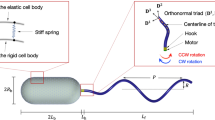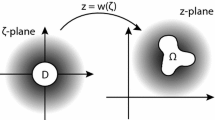Abstract
We study the dynamics and interaction of two swimming bacteria, modeled by self-propelled dumbbell-type structures. We focus on alignment dynamics of a coplanar pair of elongated swimmers, which propel themselves either by “pushing” or “pulling” both in three- and quasi-two-dimensional geometries of space. We derive asymptotic expressions for the dynamics of the pair, which complemented by numerical experiments, indicate that the tendency of bacteria to swim in or swim off depends strongly on the position of the propulsion force. In particular, we observe that positioning of the effective propulsion force inside the dumbbell results in qualitative agreement with the dynamics observed in experiments, such as mutual alignment of converging bacteria.
Similar content being viewed by others
References
Aranson, I., Tsimring, L., 2005. Pattern formation of microtubules and motors: Inelastic interaction of polar rods. Phys. Rev. E 71, 050901(R).
Aranson, I., Sokolov, A., Goldstein, R., Kessler, J., 2007. Model for dynamical coherence in thin films of self-propelled microorganisms. Phys. Rev. E 75, 040901.
Brennen, C., Winet, H., 1977. Fluid mechanics of propulsion by cilia and flagella. Ann. Rev. Fluid Mech. 9, 339–398.
Cisneros, L.H., Cortez, R., Dombrowski, C., Goldstein, R.E., Kessler, J.O., 2007. Fluid dynamics of self-propelled micro-organisms, from individuals to concentrated populations. Exp. Fluids 43, 737–753.
Diamant, H., Cui, B., Lin, B., Rice, S., 2005. Hydrodynamic interaction in quasi-two-dimensional suspensions, J. Phys., Condens. Matter.
DiLuzio, W., Turner, L., Mayer, M., Garstecki, P., Weibel, D., Berg, H., Whitesides, G., 2005. Escherichia coli swim on the right-hand side. Nature 435, 1271–1274.
Doi, M., Edwards, S.F., 1986. The Theory of Polymer Dynamics. Clarendon, Oxford.
Dombrowski, C., Cisneros, L., Chatkaew, S., Goldstein, R.E., Kessler, J.O., 2004. Self-concentration and large-scale coherence in bacterial dynamics. Phys. Rev. Lett. 93(9), 098103:1–4.
Grégoire, G., Chaté, H., 2004. Onset of collective and cohesive motion. Phys. Rev. Lett. 75, 1226–1229.
Gyrya, V., Aranson, I., Berlyand, L., Karpeev, D., 2008. A model of hydrodynamic interaction between swimming bacteria. arXiv:0805.3182v2, pp. 1–28.
Haines, B., Aranson, I., Berlyand, L., Karpeev, D., 2008. Effective viscosity of dilute bacterial suspensions: A two-dimensional model. Preprint.
Hernandez-Ortiz, J., Stoltz, C., Graham, M., 2005. Transport and collective dynamics in suspensions of confined swimming particles. Phys. Rev. Lett. 95, 204501:1–4.
Ishikawa, T., Pedley, T.J., 2007. The rheology of a semi-dilute suspension of swimming model micro-organisms. J. Fluid Mech. 588, 399–435.
Ishikawa, T., Simmonds, M.P., Pedley, T.J., 2006. Hydrodynamic interaction of two swimming model micro-organisms. J. Fluid Mech. 568, 119–160.
Kessler, J., 2000. Dynamics of swimming bacteria at low and high volume fractions. Int. Conf. Differ. Eqs. 2, 1284–1287.
Khatavkar, V.V., Anderson, P.D., den Toonder, J.M.J., Meijer, H.E.H., 2007. Active micromixer based on artificial cilia. Phys. Fluids 19, 083605.
Kim, M., Breuera, K., 2004. Enhanced diffusion due to motile bacteria. Phys. Fluids 16(9), L78–L81.
Kim, S., Karrila, S.J., 1991. Microhydrodynamics: Principles and Selected Applications. Butterworth-Heinemann, Boston.
Kitsunezaki, S., Komori, R., Harumoto, T., 2007. Bioconvection and front formation of paramecium tetraurelia. Phys. Rev. E 76, 046301.
Lighthill, J., 1976. Flagellar hydrodynamics. SIAM Rev. 18, 161–230.
Liron, N., Mochon, S., 1976. Stokes flow for a stokeslet between two parallel flat plates. J. Eng. Math. 10(4), 287–303.
Mendelson, N., Bourque, A., Wilkening, K., Watkins, J., 1999. Organized cell swimming motions in Bacillus subtilis colonies: Patterns of short-lived whirls and jets. J. Bacteriol. 181(2), 600–609.
Najafi, A., Golestanian, R., 2004. Simple swimmer and low Reynolds number: Three linked spheres. Phys. Rev. E 69, 062901.
Nasseri, S., Phan-Thien, N., 1997. Hydrodynamic interaction between two nearby swimming micromachines. Comput. Mech. 20, 551–559.
Pedley, T.J., Kessler, J.O., 1992. Hydrodynamic phenomena in suspensions of swimming microorganisms. Ann. Rev. Fluid Mech. 24, 313–358.
Pooley, C., Alexander, G., Yeomans, J., 2007. Hydrodynamic interaction between two swimmers at low Reynolds number. Phys. Rev. Lett. 99, 228103.
Purcell, E., (1977). Life at low Reynolds number. Am. J. Phys. 45(3).
Ramia, M., Tullock, D.L., Phan-Thien, N., 1993. The role of hydrodynamic interaction in the locomotion of microorganisms. Biophys. J. 65, 755–778.
Riedel, I., Kruse, K., Howard, J., 2005. A self-organized vortex array of hydrodynamically entrained sperm cells. Science 309, 300–303.
Rüffer, U., Nultsch, W., 1985. High-speed cinematographic analysis of the movement of Chlamydomonas. Cell Motil. 5, 251–263.
Saintillan, D., Shelley, M., 2007. Orientational order and instabilities in suspensions of self-locomoting rods. Phys. Rev. Lett. 99, 058102:1–4.
Short, M., Solari, C., Ganguly, S., Powers, T., Kessler, J., Goldstein, R., 2006. Flows driven by flagella of multicellular organisms enhance long-range molecular transport. Proc. Nat. Acad. Sci. (USA) 103, 8315–8319.
Simha, R., Ramaswamy, S., 2002. Hydrodynamic fluctuations and instabilities in ordered suspensions of self-propelled particles. Phys. Rev. Lett. 89(5), 058101:1–4.
Sokolov, A., Aranson, I., Kessler, J., Goldstein, R., 2007. Concentration dependence of the collective dynamics of swimming bacteria. Phys. Rev. Lett. 98, 158102.
Taylor, G., 1951. Analysis of the swimming of microscopic organisms. Proc. R. Soc. Lond. A 209, 447–461.
Wu, X.-L., Libchaber, A., 2000. Particle diffusion in a quasi-two-dimensional bacterial bath. Phys. Rev. Lett. 84, 3017–3020.
Author information
Authors and Affiliations
Corresponding author
Rights and permissions
About this article
Cite this article
Gyrya, V., Aranson, I.S., Berlyand, L.V. et al. A Model of Hydrodynamic Interaction Between Swimming Bacteria. Bull. Math. Biol. 72, 148–183 (2010). https://doi.org/10.1007/s11538-009-9442-6
Received:
Accepted:
Published:
Issue Date:
DOI: https://doi.org/10.1007/s11538-009-9442-6




